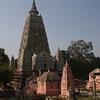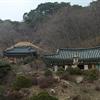A temple (from the Latin word templum) is a structure reserved for religious or spiritual activities such as prayer and sacrifice. A templum constituted a sacred precinct as defined by a priest, or augur. It has the same root as the word "template," a plan in preparation of the building that was marked out on the ground by the augur. Templa also became associated with the dwelling places of a god or gods. Despite the specific set of meanings associated with the religion of the ancient Rome, the word has now become quite widely used to describe a house of worship for any number of religions and is even used for time periods prior to the Romans.
Temples
-
 10
10Abu Simbel temples
The Abu Simbel temples are two massive rock temples at Abu Simbel, a village in Nubia, southern Egypt, near the border with Sudan. They are situated on the western bank of Lake Nasser, about 230 km southwest of Aswan (about 300 km by road).
-
 10
10A-Ma Temple, Macau
A-Ma Temple, situated on the southwest tip of the Macau Peninsula, is one of the oldest and most famous Taoist temples in Macau. Built in 1488, the temple is dedicated to Matsu, the goddess of seafarers and fishermen.
-
 10
10Brihadeeswarar Temple
Brihadeeswarar Temple is a Hindu temple dedicated to Shiva located in Thanjavur in the Indian state of Tamil Nadu. It is also known as RajaRajeswara Temple Rajarajeswaram and Brihadeshwara Temple.
-
 10
10Bulguksa
Bulguksa is located on the slopes of mount Toham. It is a head temple of the Jogye Order of Korean Buddhism and encompasses seven National treasures of South Korea, including Dabotap and Seokgatap stone pagodas, Cheongun-gyo, and two gilt-bronze statues of Buddha.
-
 10
10Deir el-Bahari (Dayr al-Bahri)
Deir el-Bahari or Dayr al-Bahri is a complex of mortuary temples and tombs located on the west bank of the Nile, opposite the city of Luxor, Egypt. This is a part of the Theban Necropolis.
-
 10
10Erechtheion
The Erechtheion or Erechtheum is an ancient Greek temple on the north side of the Acropolis of Athens in Greece which was dedicated to both Athena and Poseidon. The temple as seen today was built between 421 and 406 BCE.
-
 10
10Great Buddha Temple
The Great Buddha Temple is located about 10 kilometers from the west of Binxian County, and to the south side of Xian-Lanzhou Highway. This temple is famous for its gigantic Amitabha statue, which is delicate and majestically sculpted.
-
 6
6Haeinsa
Haeinsa is a head temple of the Jogye Order of Korean Buddhism in the Gaya Mountains , South Gyeongsang Province South Korea.
-
 10
10Jokhang (Qoikang Monastery)
The Jokhang, also known as the Qoikang Monastery, Jokang, Jokhang Temple, Jokhang Monastery and Zuglagkang, is a Buddhist temple in Barkhor Square in Lhasa, the capital city of Tibet.
-
 10
10Karnak Temple Complex
The Karnak Temple Complex, commonly known as Karnak, comprises a vast mix of decayed temples, chapels, pylons, and other buildings. Building at the complex began during the reign of Senusret I in the Middle Kingdom and continued into the Ptolemaic period, although most of the extant buildings date from the New Kingdom.
-
 10
10Khajuraho Group of Monuments
The Khajuraho Group of Monuments is a group of Hindu and Jain temples in Madhya Pradesh, India. The temples are famous for their nagara-style architectural symbolism and their erotic sculptures.
-
 10
10Luxor Temple
Luxor Temple is a large Ancient Egyptian temple complex located on the east bank of the Nile River in the city today known as Luxor (ancient Thebes) and was founded in 1400 BCE. Known in the Egyptian language as ipet resyt, or "the southern sanctuary".
-
 8
8Mahabodhi Temple
The Mahabodhi Vihar, a UNESCO World Heritage Site, is a Buddhist temple in Bodh Gaya, marking the location where the Buddha is said to have attained enlightenment.
-
 6
6Mortuary Temple of Hatshepsut, Deir el-Bahari
The Mortuary Temple of Queen Hatshepsut, the Djeser-Djeseru ("Holy of Holies"), is located beneath the cliffs at Deir el Bahari on the west bank of the Nile near the Valley of the Kings in Egypt.
-
 8
8Na Tcha Temple, Macau
The Na Tcha Temple, built in 1888, is a Chinese folk religion temple in Macau, China dedicated to the worship of the deity Na Tcha. The Na Tcha Temple was built in homage to the child god of war.
-
 10
10Pashupatinath Temple
The Pashupatinath Temple is a famous, sacred Hindu temple dedicated to Pashupatinath and is located on the banks of the Bagmati River 5 kilometres north-east of Kathmandu Valley in the eastern city of Kathmandu, the capital of Nepal.
-
 9
9Putuo Zongcheng Temple
The Putuo Zongcheng Temple of Chengde, Hebei province, China is a Qing dynasty era Buddhist temple complex built between 1767 and 1771, during the reign of the Qianlong Emperor (1735–1796).
-
 5
5Sakhargad Nivasini (Yamai)
Built in the 18th century, the Yamai or Sakhargad Niwasini temple complex, with its different structures and unique, extensive fortifications, is full of surprises in terms of fine craftsmanship, unique and popular folk art, graceful fusion of Yadava Period and Bahamani styles of architecture.
-
 8
8Seokguram
The Seokguram Grotto is a hermitage and part of the Bulguksa temple complex. It lies four kilometers east of the temple on Mt. Tohamsan, in Gyeongju, South Korea.
-
 10
10Shore Temple, Mahabalipuram
The Shore Temple (built in 700–728 AD) is so named because it overlooks the shore of the Bay of Bengal. It is a structural temple, built with blocks of granite, dating from the 8th century AD
-
 2
2Temple of Apollo Epikourios, Bassae
The temple was dedicated to Apollo Epikourios ("Apollo the helper"). It was designed by Iktinos, architect at Athens of the Temple of Hephaestus and the Parthenon. The ancient writer Pausanias praises the temple as eclipsing all others but the temple of Athena at Tegea by the beauty of its stone and the harmony of its construction.
-
 10
10Temple of Confucius
The Temple of Confucius in Qufu, Shandong Province, is the largest and most renowned temple of Confucius in East Asia.
-
 10
10Temple of Heaven
The Temple of Heaven, is a medieval complex of religious buildings situated in the southeastern part of central Beijing.
-
 10
10Temple of Hibis
The Temple of Hibis (Egyptian: Hebet meaning the plough), Persian - c. 6th century BCE, is the largest and most well preserved temple in the Kharga Oasis. Excavations were started out early during the 20th century.
-
 1
1Temple of Nadura (Ruins), near the Kharga Oasis
The temple is located just a little over a mile outside of El Kharga and was built by the Romans either during the rule of Antoninus Pius or Hadrian.


